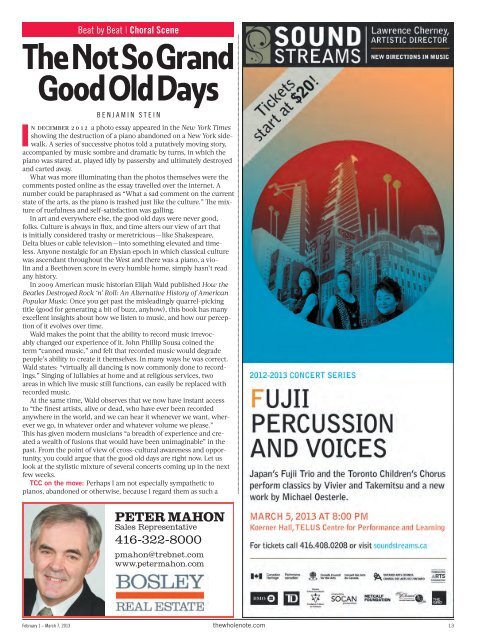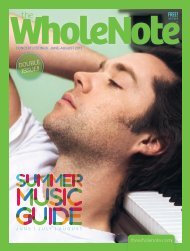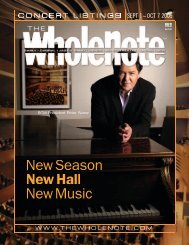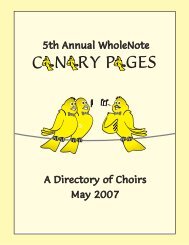Create successful ePaper yourself
Turn your PDF publications into a flip-book with our unique Google optimized e-Paper software.
Beat by Beat | Choral Scene<br />
The Not So Grand<br />
Good Old Days<br />
BENJAMIN STEIN<br />
In december 2 0 1 2 a photo essay appeared in the New York Times<br />
showing the destruction of a piano abandoned on a New York sidewalk.<br />
A series of successive photos told a putatively moving story,<br />
accompanied by music sombre and dramatic by turns, in which the<br />
piano was stared at, played idly by passersby and ultimately destroyed<br />
and carted away.<br />
What was more illuminating than the photos themselves were the<br />
comments posted online as the essay travelled over the internet. A<br />
number could be paraphrased as “What a sad comment on the current<br />
state of the arts, as the piano is trashed just like the culture.” The mixture<br />
of ruefulness and self-satisfaction was galling.<br />
In art and everywhere else, the good old days were never good,<br />
folks. Culture is always in flux, and time alters our view of art that<br />
is initially considered trashy or meretricious — like Shakespeare,<br />
Delta blues or cable television — into something elevated and timeless.<br />
Anyone nostalgic for an Elysian epoch in which classical culture<br />
was ascendant throughout the West and there was a piano, a violin<br />
and a Beethoven score in every humble home, simply hasn’t read<br />
any history.<br />
In 2009 American music historian Elijah Wald published How the<br />
Beatles Destroyed Rock ‘n’ Roll: An Alternative History of American<br />
Popular Music. Once you get past the misleadingly quarrel-picking<br />
title (good for generating a bit of buzz, anyhow), this book has many<br />
excellent insights about how we listen to music, and how our perception<br />
of it evolves over time.<br />
Wald makes the point that the ability to record music irrevocably<br />
changed our experience of it. John Phillip Sousa coined the<br />
term “canned music,” and felt that recorded music would degrade<br />
people’s ability to create it themselves. In many ways he was correct.<br />
Wald states: “virtually all dancing is now commonly done to recordings.”<br />
Singing of lullabies at home and at religious services, two<br />
areas in which live music still functions, can easily be replaced with<br />
recorded music.<br />
At the same time, Wald observes that we now have instant access<br />
to “the finest artists, alive or dead, who have ever been recorded<br />
anywhere in the world, and we can hear it whenever we want, wherever<br />
we go, in whatever order and whatever volume we please.”<br />
This has given modern musicians “a breadth of experience and created<br />
a wealth of fusions that would have been unimaginable” in the<br />
past. From the point of view of cross-cultural awareness and opportunity,<br />
you could argue that the good old days are right now. Let us<br />
look at the stylistic mixture of several concerts coming up in the next<br />
few weeks.<br />
Tcc on the move: Perhaps I am not especially sympathetic to<br />
pianos, abandoned or otherwise, because I regard them as such a<br />
PETER MAHON<br />
Sales Representative<br />
416-322-8000<br />
pmahon@trebnet.com<br />
www.petermahon.com<br />
February 1 – March 7, 2013 thewholenote.com 13

















